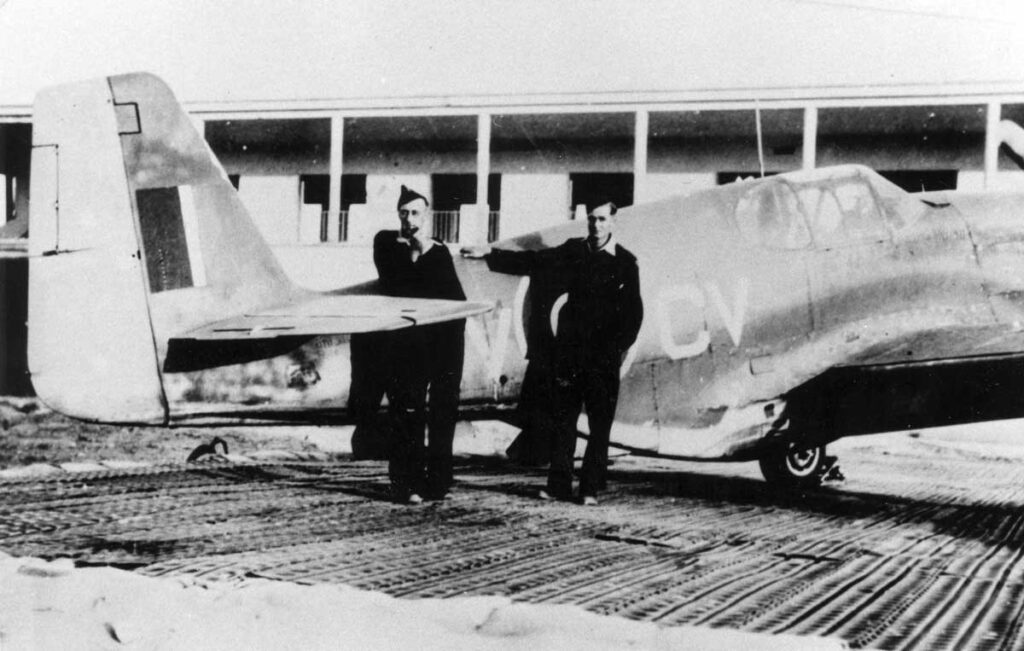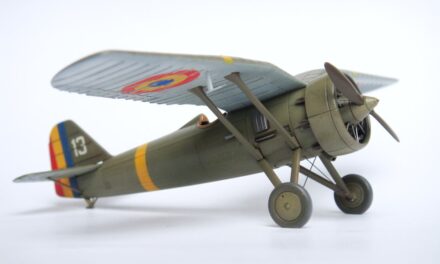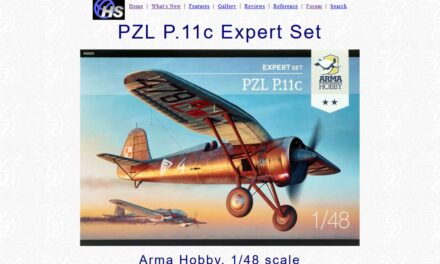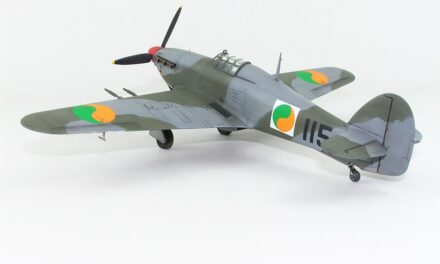
The P-51 Mustang fighter is an iconic aircraft of the Second World War. Developed in response to an order placed by the Royal Air Force, it was fitted with the Packard Merlin V-1650-3 engine (manufactured under licence from Rolls-Royce),and later with the V-1650-7, ultimately going down in history as the aircraft that brought the Luftwaffe to its knees. Its phenomenal range allowed the Allies to engage the enemy at locations which had hitherto been outside the reach of their fighters. The majority of Mustangs with Merlin engines (versions B/C/D/K) were received by the USAAF, however under the programme of Lend-Lease the air forces of the British Commonwealth (the RAF, RAAF, RCAF and SAAF) and the Polish Air Forces in Great Britain were also equipped with the fighter. One of the units which flew the Mustang during the conflict was No. 3 Squadron Royal Australian Air Force (RAAF).
Before the Mustangs
No. 3 Squadron Royal Australian Air Force (RAAF) was formed on 19 September 1916 at Point Cook in the Australian state of Victoria. On 25 October of that year it was sent to Great Britain, where the pilots underwent training, while in August 1917 (now termed No. 69 Squadron, Royal Flying Corps by the British) it was transferred to France. It fought there until the end of the war, shooting down 51 enemy aircraft. In January 1918, the unit received its final number, but in February 1919 it was disbanded. Six years later, however, the squadron was reactivated, being tasked primarily with meteorological and photographic flights.

Pilots of No. 3 Squadron, Royal Australian Air Force, run to their Curtiss Tomahawk IIA fighters to “scramble” in North Africa. Photo: Wikimedia Commons.
Following the outbreak of the Second World War, RAAF Command came to the conclusion that Australian squadrons had insufficient combat strength, which it duly decided to augment before sending them off to the front line. Finally, on 24 July 1940, No. 3 Squadron RAAF departed for the Middle East, arriving at its destination on 23 August. In Egypt, the unit was equipped with Gloster Gladiators (two flights) and Westland Lysanders (one flight), entering combat on 19 November 1940. The pilots quickly discovered that their aeroplanes were rather unsuited for front line service. Already in January, however, the unit received its first Hurricanes. Following re-equipment, the airmen were finally able to play a meaningful role in the fight against the Reggia Aeronautica and the Luftwaffe. When the Afrika Korps surrounded Tobruk, No. 3 Squadron sent its aeroplanes to an airfield located within the defensive fortifications, from where it regularly sortied against enemy bombers. In May, the squadron started its adventure with the Curtiss P-40, which lasted until November 1944. Initially, during the invasion of Syria, it operated the B version of the fighter. The unit later returned to the Libyan front, while in December it was re-equipped with the Curtiss P-40E. While flying these aircraft, No. 3 Squadron took part, among others, in the Battle of El Alamein, and thereafter in the pursuit of the enemy, which ended with the capitulation of Axis forces in North Africa. No. 3 Squadron RAAF was the sole operational unit of its kind in the Western Desert Air Force to take part in all of the campaigns conducted in North Africa.
The unit was provided with new fighters immediately prior to the invasion of Sicily. Yet again, these were Curtisses, however powered by a Rolls-Royce Merlin engine. In 1944, the Kittyhawk II was replaced with the Kittyhawk IV, and this version was used by the squadron in the fighter-bomber role (just like in Africa) until November.
The Mustangs Arrive
The unit’s Operations Record Book (ORB) contains the following entry for 17 November 1944: “Effective today, the squadron has been withdrawn from combat in order for pilots to receive training on Mustang aircraft”. On that day No. 3 Squadron RAAF became the first Australian unit to operate the fighter. Specifically, these were Mustang IIIs, or Mustang P-51C-1s and C-10s, and Mustang IVs (P-51K-1s, and later also K-5s and K-10s).
Training lasted until 21 November, and already on 22 November six aeroplanes, commanded by S/L Murray Percival Nash DSO, DFC and Bar, embarked on their first combat mission (denoted as a “Special Mission” in the ORB), during which they escorted a Lysander flying towards northern Italy. Tragically, the operation was cut short by Mustangs of the USAAF, which downed the Lysander before its escorts had a chance to intervene. The matter must have been serious, for it was to be the subject of a court martial. Over the next few weeks, weather permitting, the squadron performed reconnaissance flights, provided escort cover, or – as was most often the case – attacked ground targets in Italy and the Kingdom of Yugoslavia using 500-pound bombs. A closer reading of the unit’s ORB shows that whenever conditions allowed, the pilots flew two or even three missions a day. It is therefore clear that the Mustangs were actively used right until the end of the war. On 6 May 1945, the following was written down in the unit’s Operations Record Book: “The war has drawn to close in this theatre of military operations, and no further operational flights are required”. Two days later, on 8 May, the pilots of No. 3 Squadron celebrated Victory in Europe Day.
 Mustang Mustang III, FB244/CV-V, Spring 1945.
Mustang Mustang III, FB244/CV-V, Spring 1945.
Mustang III/FB244
One of the paint schemes selected by Arma Hobby is that of a North American Mustang III with the markings CV-V/FB244 during its period of service with No. 3 Squadron RAAF. The aeroplane was manufactured as a P-51C-1 at the Dallas plant. Initially sent to No. 112 Squadron of the Royal Air Force, in the beginning of April 1945 it was transferred to No. 3 Squadron RAAF, where it replaced a Mustang III (specifically CV-V/KH631) which had been lost on 3 April to ground fire. The aeroplane took part in its first mission on 6 April. That day W/O Redenbach, accompanied by F/L Edmonds on Mustang III/FB299, set off on a fighter patrol in the hope of intercepting Luftwaffe jet aircraft. However, they failed to encounter any enemy aeroplanes. The next flight took place on 7 April. W/O Rumsby, together with seven other pilots, attacked a railway line in the vicinity of Pordenone. A day later, W/O Redenbach, again flying CV-V, bombed rail targets near Latisan. The next day, our P-51C participated in two bombing raids, both of which were focused on enemy-occupied structures and facilities. In successive days, the Mustang was flown by various pilots in support of ground forces, among others in so-called cab rank missions (which consisted in maintaining an airborne reserve of fighter-bomber aircraft that could be called in at short notice to provide close air support). Since No. 3 Squadron usually sent four Mustangs on each mission of this type, it was able handle a number of sorties per day – for example, on 13 April the unit dispatched its aircraft to six separate “cab ranks” (FB244 participated twice).

Mustang III FB244/OK-F in the 450 Squadron RAAF, June 1945. Photo ADF serials.
The fighter’s last combat flight was a patrol over Trieste on 5 May 1945, during which it was piloted by F/S McDonald. No enemy aeroplanes were encountered. A short time later, the aircraft was transferred to No. 450 Squadron RAAF, with which it remained until the unit’s dissolution in August 1945. It was then sent to No. 380 Maintenance Unit, and scrapped on 1 October 1946.
Paint Scheme and Structural Details
Officially, all of the Mustangs operated by No. 3 Squadron RAAF should have received Day Fighter camouflage, this comprising Dark Green and Ocean Grey on the upper and side surfaces, and Medium Sea Grey on the undersides. However, the aircraft were delivered from factories painted with American equivalents of the paints used by the RAF, namely ANA 613 Olive Drab and ANA 603 Sea Grey on the upper surfaces, and ANA 602 Light Grey on the undersides. We should stress here that the ANA colours differed as regards composition and hue from the Federal Standard palette that is currently available.
As was mentioned above, Mustang CV-V/FB244, a P-51C-1, was manufactured at the North American plant in Dallas and allocated USAAF number 42-103138. It was delivered with a factory camouflage made with American ANA paints. Here, unfortunately, we encounter a problem concerning the arrangement of blotches, for Australian authors give two possibilities:
1. The “T.O” camouflage in which factory-painted Mustangs were delivered (picture below, courtesy Steve McKenzie). 

2. The “Firewall” camouflage (so called because the line of division between green and grey at the front of the fuselage ran along the firewall immediately in front of the cockpit) made using RAF paints. 
Only two photographs of number FB244 are known. In one, it is shown in the livery of No. 3 Squadron RAAF, and in the other in that of No. 450 Squadron RAAF. Unfortunately, it is rather difficult to conclude which pattern was actually used. The first picture is somewhat unclear, and it is hard to make out the colours. The second, while considerably more legible, presents the aircraft with a strongly faded paint scheme. We can only see the division of colours just behind the cockpit and in the middle of the fuselage cockade – which does not make matters any easier, for at this point of the fuselage the division between colours was very similar in both patterns. At Arma Hobby we think that the aircraft could have been repainted in “Firewall” camouflage using RAF colours. The final decision will have to be taken by modellers themselves. Another characteristic feature of the Mustang IIIs flown by No. 3 Squadron RAAF was the Southern Cross painted on the rudder against a blue background. Sources state unanimously that the rudder was painted in Medium Blue. Our aircraft kept this marking after it was transferred to No. 450 Squadron RAAF.

Another RAAF Mustang III in Italy, in 1945 , KH624/CV-Y.
The aeroplane did not have the Sky stripe, typical of RAF aircraft flying in north-western Europe, or the white stripes painted on the wings and horizontal stabilizers of USAAF and RAF Mustangs operating from the British Isles. Finally, the wing leading edges of the Mustangs of No. 3 Squadron RAAF were not painted yellow.
The fighter did not have a tail fin and was from the B/C series of Mustangs, which were fitted with an additional hot air intake for the carburettor behind the exhaust pipes. Interestingly, the majority of Mustang IIIs used by the RAAF retained the original cockpit canopy – as opposed to the Mustang IIIs operated by RAF units in Great Britain, which were provided with Malcolm hoods. The final element of the paint scheme was the red propeller spinner – a marking characteristic of aircraft of the RAF’s “Desert Air Force” serving in Africa and Italy.
Acknowledgements
The present article would not have been written if not for the help of Steve Mackenzie, who provided materials describing the Mustang IIIs operated by No. 3 Squadron RAAF.
English translation by Maciek Zakrzewski
Bibliography:
- Operations Record Book 3. Dywizjon RAAF
- RAAF 3 Squadron Association (3AFC Australian Flying Corps)
- Steve Mackenzie. 3 Sqn RAAF Mustang IIIs – a Reassessment
- Robert Pęczkowski. North American Aviation P-51B/C & F-6C Mustang. MMP Books 2019
See also:
- Buy P-51 B/C Mustang™ Expert Set and other model kits in Arma Hobby link
‘I claim an ME 262 destroyed’ – the story of Jerzy Mencel and his Mustang III
An enthusiast of air war during the Battle of Britain, over North Africa and Italy, over South East Asia and France in 1940. In free time builds models in 1/72 scale, and from time to time in 1/48 scale.
This post is also available in:
 polski
polski







